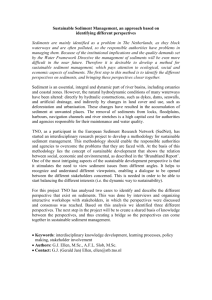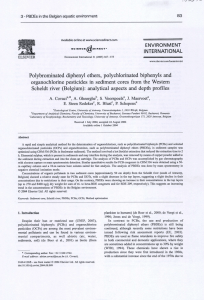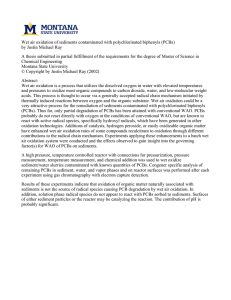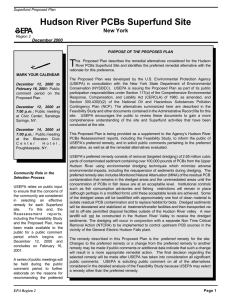Experiment #2
advertisement
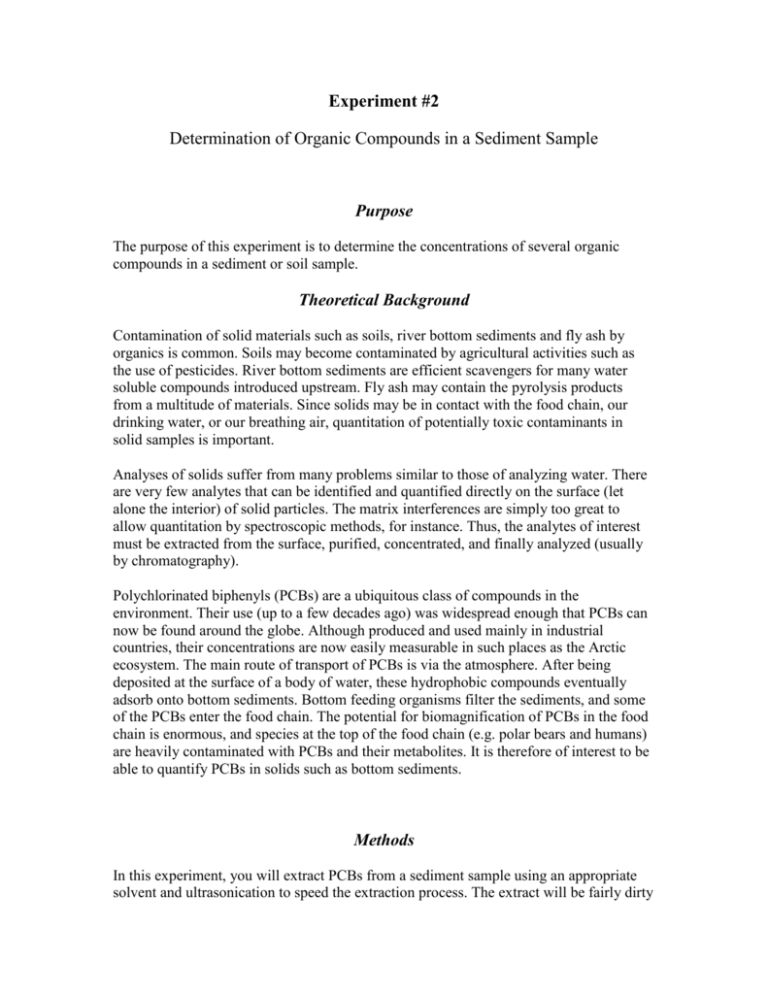
Experiment #2 Determination of Organic Compounds in a Sediment Sample Purpose The purpose of this experiment is to determine the concentrations of several organic compounds in a sediment or soil sample. Theoretical Background Contamination of solid materials such as soils, river bottom sediments and fly ash by organics is common. Soils may become contaminated by agricultural activities such as the use of pesticides. River bottom sediments are efficient scavengers for many water soluble compounds introduced upstream. Fly ash may contain the pyrolysis products from a multitude of materials. Since solids may be in contact with the food chain, our drinking water, or our breathing air, quantitation of potentially toxic contaminants in solid samples is important. Analyses of solids suffer from many problems similar to those of analyzing water. There are very few analytes that can be identified and quantified directly on the surface (let alone the interior) of solid particles. The matrix interferences are simply too great to allow quantitation by spectroscopic methods, for instance. Thus, the analytes of interest must be extracted from the surface, purified, concentrated, and finally analyzed (usually by chromatography). Polychlorinated biphenyls (PCBs) are a ubiquitous class of compounds in the environment. Their use (up to a few decades ago) was widespread enough that PCBs can now be found around the globe. Although produced and used mainly in industrial countries, their concentrations are now easily measurable in such places as the Arctic ecosystem. The main route of transport of PCBs is via the atmosphere. After being deposited at the surface of a body of water, these hydrophobic compounds eventually adsorb onto bottom sediments. Bottom feeding organisms filter the sediments, and some of the PCBs enter the food chain. The potential for biomagnification of PCBs in the food chain is enormous, and species at the top of the food chain (e.g. polar bears and humans) are heavily contaminated with PCBs and their metabolites. It is therefore of interest to be able to quantify PCBs in solids such as bottom sediments. Methods In this experiment, you will extract PCBs from a sediment sample using an appropriate solvent and ultrasonication to speed the extraction process. The extract will be fairly dirty and will thus require some cleanup procedures. The cleaned extract will be analyzed by GC/ECD. Experimental 1. Extraction (i) Accurately weigh out a roughly 10 g sample of the reference marine sediment into a 100 mL beaker. (ii) Add approximately 20 mL of hexane. If this amount of solvent does not more than cover the sediment, add enough until it does. All of the sediment must be wetted, and there should be about 1 cm of solvent above the sediment. (iii) Cover the beaker with aluminum foil, and sonicate for 8-10 hours. (iv) Allow the sediment to settle, then decant it into a clean glass vessel. (v) Wash the beaker twice with a few mL of hexane by decanting as above. 2. Cleanup Florisil Column - This step removes biogenic material such as lipids and proteins that would otherwise interfere with the GC/ECD analysis. (i) Make a small cleanup column by packing a Pasteur pipette with Florisil. Keep the Florisil in the tube with a small wad of glass wool at either end. (ii) Pass the liquid extract into the Florisil column, using a clean dropper to add extract to the top of the column, collecting the eluate in another clean vessel below (iii) Wash the column with a few mL of clean extraction solvent. Copper Metal - This step removes sulfur containing compounds which would otherwise result in large peaks on the ECD, obliterating the PCB peaks. (i) Weigh out 1.0 g copper metal powder (ii) Place the copper in a small funnel on filter paper. (iii) Wash with 10 mL 3 M HNO3 to reduce any oxides on the surface. (iv) Wash with distilled water, then with acetone. Dry thoroughly. (v) Add the copper metal to the extract and stir for 1 h. The extract may be stored in a fridge at this point if it will not be analyzed immediately. 3. Analysis (i) Allow the extract to come to room temperature before opening it. Otherwise moisture may condense into it. Excessive water can damage the GC column (DB5). (ii) Set up the temperature program and gas flows on the Varian CP-3380 GC as follows (some of these values may have been preset for you - ask the TA!): Injector temperature: 200oC Detector temperature: 300oC Column program: 80oC for 1 minute, ramped to 280oC at 10oC/minute, held at 280oC for 9 minutes. Carrier gas: 1 mL/min He Makeup gas: 30 mL/min nitrogen (iii) Make 0.5 and 1.0 ppb standards in hexane by serially diluting the concentrated PCB stock solution. Glass pipettes must be used for organic solutions involving hydrocarbons. (iv) Analyze each solution by GC/ECD. Sum the areas of all peaks, and plot this versus total PCB concentration. This plot should be linear! (v) Analyze your extract, and calculate the total concentration of PCBs in it. Back calculate to find the PCB concentration (g/g) in the sediment sample. (vi) By recording the areas of individual peaks in both the extract and the standard, determine whether the pattern of PCBs has changed in the sample due to weathering.



